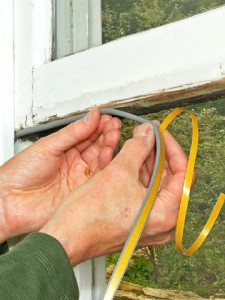
19 Sep EcoAction Partners: Stay Warm in Winter, Reduce Energy Use
As snow begins to fall on the highest peaks around Telluride, I can’t help thinking of winter. I’ve managed to avoid turning the heat on in my small apartment, but know that colder outdoor temperatures are quickly approaching. I haven’t yet spent a winter in my new abode, so I have been thinking of ways to keep my utilities bill low during the cold months and reduce my energy use. Using weatherization techniques to keep your home warm in the winter reduces your dependency on coal-fired power and your contribution to greenhouse gas emissions. Reducing your energy use saves gobs of cash in the long run, with the added benefit of reducing your greenhouse gas emissions and your carbon footprint. Here are some of the suggestions I’ve found to simply, easily, and (super) affordably add “retrofits” to your own apartment or home, broken down by category in the home.
Heating Systems
• Keep your thermostat set at 68 degrees while you’re home, and dial it back 10 – 15 degrees while you’re away or asleep. You can save up to 15% per year on your heating bill. For my 700 square foot apartment, for example, I can save as much as $200 per year without sacrificing any comfort. In fact, studies have found the best sleep temperatures for most people are between 60 and 68 degrees F. (New York Times)
• Invest in a digital, programmable thermostat you can set for energy savings based on your work, vacation, or sleep schedule. They’re as inexpensive as $30 for some models. You’ll save money on heating and save time spent fiddling with the thermostat.
Windows, Doors, and Floors
• Reduce drafts in your home for a more comfortable indoor environment and savings on utilities – caulk around window and door frames and use weatherstripping to seal spaces around operable windows and doors. (energy.gov)
• Add a thick rug with a pad underneath to your wood floors in winter to decrease heat loss.
• Heat-trapping curtains for your windows (really, any curtains) and plastic shrink-wrap window insulation found at any hardware store can vastly decrease heat loss through window glass and frames.
These are just a few ways to maximize your energy savings in your home, with minimal impact on your wallet and time. For renters, these are also improvements that are easily reversible and can travel with you whenever you move.
For more information about ways to save money, lessen your environmental impact, and reduce your energy use, visit the energy pages on our website here, and stay tuned for more on our winter energy-saving competition, Truth or Dare!



Sorry, the comment form is closed at this time.